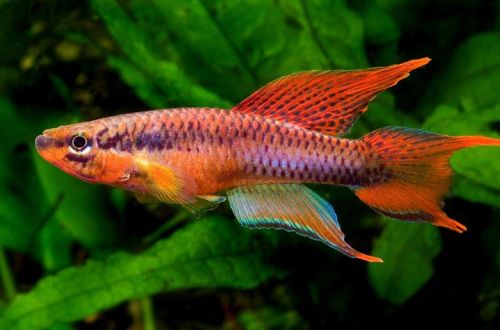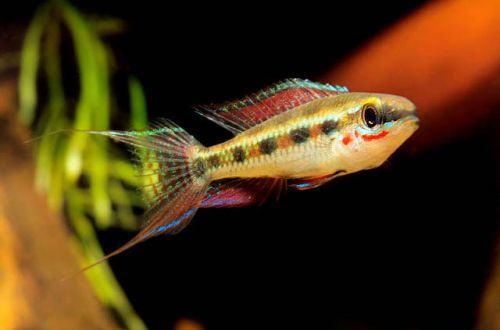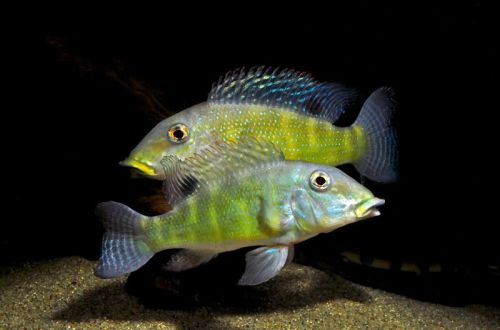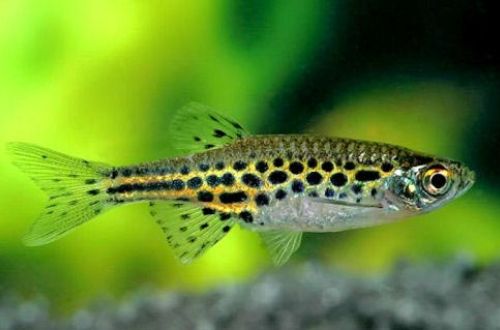
Afosemion cu două benzi
Afiosemion two-lane, scientific name Aphyosemion bitaeniatum, belongs to the family Nothobranchiidae (Notobranchiaceae). Easy to keep bright fish. Can adapt to a wide range of conditions. The disadvantages include a short lifespan, which is usually 1-2 seasons.

Cuprins
Habitat
Comes from equatorial Africa. It is widely distributed in the swampy coastal areas of Togo, Benin and Nigeria, as well as in the lower Niger river basin. Inhabits shallow streams, backwaters, lakes in the rainforest litter, in which the depth varies between 1–30 cm. Sometimes these are just temporary puddles. The bottom is covered with a layer of fallen leaves, branches and other plant organic matter. The water level in reservoirs is not stable, complete drying up is not uncommon.
Informatie scurta:
- Volumul acvariului – de la 40 de litri.
- Temperatura – 20-24°C
- Valoare pH — 5.0–6.5
- Duritatea apei – moale (1-6 dGH)
- Tip de substrat – orice
- Iluminare – slabă
- Apa salmastra – nr
- Mișcarea apei – puțin sau deloc
- Dimensiunea peștelui este de 4-5 cm.
- Mese – orice bogată în proteine
- Temperament – pașnic
- Conținut într-un grup de cel puțin 4-5 persoane
Descriere
Adults reach a length of 4-5 cm. Males look more colorful than females and have enlarged anal, dorsal and caudal fins, painted in red with turquoise edges, and with a pattern of small specks. Two dark stripes run along the body, stretching from head to tail. There is a variety called “Lagos red”, characterized by a predominance of red.
Females are noticeably more modest. The fins are short and translucent. The color of the body is gray-silver. Like males, they have a pattern on the body of two stripes.
Alimente
The basis of the diet should be live or frozen food, such as bloodworms, daphnia, brine shrimp, mosquito larvae, fruit flies, etc. Can be accustomed to dry food, provided that they are rich in protein.
Întreținere și îngrijire, amenajarea acvariului
In nature, two-banded Afiosemione live in conditions that will be extreme for many fish. Such adaptability predetermined rather low requirements for the care of these fish species. They can be kept in small aquariums from 20-40 liters. The water temperature should not exceed 24°C. They prefer soft, acidic water, but also tolerate higher dGH values. The tank should be covered with a lid or only half full, this will prevent the fish from jumping out. In their natural environment, by jumping, they move from one body of water / puddle to another when drying occurs. In the design, it is recommended to use a large number of floating and rooting plants, as well as a layer of leaves. You can find out which leaves can be used in an aquarium in a separate article. The lighting is subdued. Any substrate, but if breeding is planned, then it is worth using special fibrous materials, thickets of small-leaved mosses, etc.
Comportament și compatibilitate
Usually, Killy fish are kept in species aquariums. However, it is acceptable to be in the company of other miniature peace-loving species. Males of Afiosemion biband differ in territorial behavior and compete with each other. In small aquariums, it is worth buying a group with one male and several females.
Creștere / reproducere
If the fish live in a common aquarium, then it is advisable to breed in a separate tank. Optimum conditions are achieved in soft (up to 6 dGH) slightly acidic (about 6.5 pH) water at a temperature of 22–24 C°. Feed foods with a high protein content, or exclusively live foods. Eggs are laid in a dense layer of moss or a special spawning substrate. Caviar matures in 12-14 days. The fry that have appeared should also be planted in a separate container with identical water parameters. In the first 2–3 weeks, water filtration should be avoided, otherwise there is a high risk of juveniles getting into the filter. Water is partially replaced with fresh water once a week and uneaten food residues are removed in a timely manner to prevent excessive contamination.
Bolile peștilor
Condițiile de viață adecvate reduc la minimum probabilitatea apariției unei epidemii. Amenințarea este utilizarea hranei vii, care este adesea purtătoare de paraziți, dar imunitatea peștilor sănătoși le rezistă cu succes. Citiți mai multe despre simptome și tratamente în secțiunea Boli ale peștilor de acvariu.





